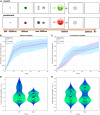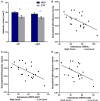Association between habenula dysfunction and motivational symptoms in unmedicated major depressive disorder
- PMID: 28575424
- PMCID: PMC5629818
- DOI: 10.1093/scan/nsx074
Association between habenula dysfunction and motivational symptoms in unmedicated major depressive disorder
Abstract
The lateral habenula plays a central role in reward and punishment processing and has been suggested to drive the cardinal symptom of anhedonia in depression. This hypothesis is largely based on observations of habenula hypermetabolism in animal models of depression, but the activity of habenula and its relationship with clinical symptoms in patients with depression remains unclear. High-resolution functional magnetic resonance imaging (fMRI) and computational modelling were used to investigate the activity of the habenula during a probabilistic reinforcement learning task with rewarding and punishing outcomes in 21 unmedicated patients with major depression and 17 healthy participants. High-resolution anatomical scans were also acquired to assess group differences in habenula volume. Healthy individuals displayed the expected activation in the left habenula during receipt of punishment and this pattern was confirmed in the computational analysis of prediction error processing. In depressed patients, there was a trend towards attenuated left habenula activation to punishment, while greater left habenula activation was associated with more severe depressive symptoms and anhedonia. We also identified greater habenula volume in patients with depression, which was associated with anhedonic symptoms. Habenula dysfunction may contribute to abnormal response to punishment in patients with depression, and symptoms such as anhedonia.
Keywords: anhedonia; depression; fMRI; habenula; prediction error; punishment.
© The Author (2017). Published by Oxford University Press.
Figures





Similar articles
-
Impaired reward prediction error encoding and striatal-midbrain connectivity in depression.Neuropsychopharmacology. 2018 Jun;43(7):1581-1588. doi: 10.1038/s41386-018-0032-x. Epub 2018 Feb 26. Neuropsychopharmacology. 2018. PMID: 29540863 Free PMC article.
-
Neural mechanisms of reinforcement learning in unmedicated patients with major depressive disorder.Brain. 2017 Apr 1;140(4):1147-1157. doi: 10.1093/brain/awx025. Brain. 2017. PMID: 28334960
-
Habenula responses to potential and actual loss in major depression: preliminary evidence for lateralized dysfunction.Soc Cogn Affect Neurosci. 2016 May;11(5):843-51. doi: 10.1093/scan/nsw019. Epub 2016 Feb 15. Soc Cogn Affect Neurosci. 2016. PMID: 26884545 Free PMC article.
-
Reward processing by the lateral habenula in normal and depressive behaviors.Nat Neurosci. 2014 Sep;17(9):1146-52. doi: 10.1038/nn.3779. Nat Neurosci. 2014. PMID: 25157511 Free PMC article. Review.
-
Reward systems and cognitions in Major Depressive Disorder.CNS Spectr. 2019 Feb;24(1):64-77. doi: 10.1017/S1092852918001335. Epub 2018 Nov 26. CNS Spectr. 2019. PMID: 30472971 Review.
Cited by
-
Impaired reward prediction error encoding and striatal-midbrain connectivity in depression.Neuropsychopharmacology. 2018 Jun;43(7):1581-1588. doi: 10.1038/s41386-018-0032-x. Epub 2018 Feb 26. Neuropsychopharmacology. 2018. PMID: 29540863 Free PMC article.
-
Cognitive-behavioral therapy to normalize social learning for patients with major depressive disorders: study protocol for a single-arm clinical trial.BMC Psychol. 2025 Apr 29;13(1):453. doi: 10.1186/s40359-025-02759-0. BMC Psychol. 2025. PMID: 40302007 Free PMC article.
-
Challenging the negative learning bias hypothesis of depression: reversal learning in a naturalistic psychiatric sample.Psychol Med. 2022 Jan;52(2):303-313. doi: 10.1017/S0033291720001956. Epub 2020 Jun 15. Psychol Med. 2022. PMID: 32538342 Free PMC article.
-
Anhedonia in Depression and Schizophrenia: Brain Reward and Aversion Circuits.Neuropsychiatr Dis Treat. 2022 Jul 7;18:1385-1396. doi: 10.2147/NDT.S367839. eCollection 2022. Neuropsychiatr Dis Treat. 2022. PMID: 35836582 Free PMC article. Review.
-
Segmentation and Volume Estimation of the Habenula Using Deep Learning in Patients With Depression.Biol Psychiatry Glob Open Sci. 2024 Apr 3;4(4):100314. doi: 10.1016/j.bpsgos.2024.100314. eCollection 2024 Jul. Biol Psychiatry Glob Open Sci. 2024. PMID: 38726037 Free PMC article.
References
-
- Accolla E.A., Aust S., Merkl A., et al. (2016). Deep brain stimulation of the posterior gyrus rectus region for treatment resistant depression. Journal of Affective Disorders, 194, 33–7. - PubMed
-
- APA (1994). Diagnostic and Statistical Manual of Mental Disorders. Washington, DC: American Psychiatric Press.
-
- Beck A.T., Guth D., Steer R.A., Ball R. (1997). Screening for major depression disorders in medical inpatients with the Beck Depression Inventory for Primary Care. Behaviour Research and Therapy, 35, 785–91. - PubMed
-
- Beck A.T., Kovacs M., Weissman A. (1979). Assessment of suicidal intention: the scale for suicide ideation. Journal of Consulting and Clinical Psychology, 47, 343–52. - PubMed
MeSH terms
Grants and funding
LinkOut - more resources
Full Text Sources
Other Literature Sources
Molecular Biology Databases

